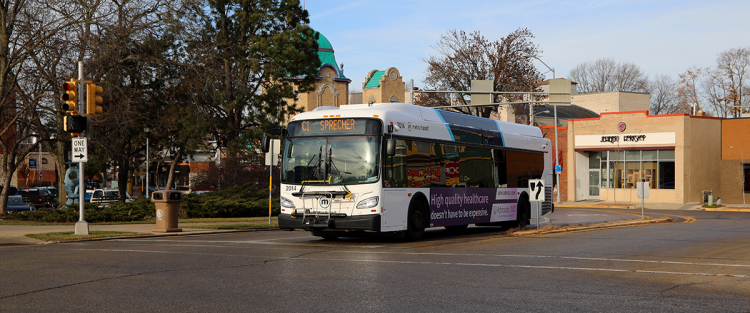
- English
- Hmoob
templink

Metro has received some questions on how the upcoming bus rapid transit system is affecting the City of Madison budget.
Review Budget Slide Presentation
If you would like to see additional questions to add to this FAQ, email mymetrobus@cityofmadison.com.
Q: Does BRT increase Metro’s operating budget?
A: No. The BRT infrastructure investment will speed up the buses on Route A, having the effect of providing faster travel times to our customers while also reducing the number of Metro bus driver hours it takes to provide that service.
Currently Route A buses run 2,735 miles each day and require 200 hours of bus driver time to do that, for an overall average of 13.7 miles per hour.
By investing in dedicated lanes, traffic signal enhancements, and quicker boarding at stations, Metro expects that average speed to increase to at least 16 miles per hour.
That would mean that that to run the same number of miles, we would need 170 hours of bus driver time.
Saving those 30 hours per day over the course of the year will save Metro at least $250,000 each year.
However, that new infrastructure will require some additional cost to maintain, potentially up to that same $250,000.
So, the total effect of BRT is faster service for riders and an operating budget impact that is, at worst, a break-even.
Q: Didn’t BRT increase general property tax bills for capital expenses?
A: Only slightly more than pre-BRT plans.
Metro’s 2019 capital budget (the last one where BRT was not included) shows that the City assumed that $15.2 million in general obligation borrowing would be required to replace 45 40-ft. diesel buses over the 2022-2024 time period (15 each year) due to normal life cycle replacements.
There is a total of $21.7 million of general obligation borrowing authorized as part of the BRT project, with the rest coming from other sources – primarily federal grants.
In addition to the construction, the BRT project is providing 46 new 60-ft. electric buses to Metro, which fulfilled our regular bus replacement needs for that three-year period.
So Metro was able to get more buses, with upgraded size and electric propulsion, while spending just $6.5 million more in general obligation borrowing than if we had proceeded with the status quo.
The BRT project also used $20 million of Tax Increment Financing (TIF) funds. These are property taxes that are generated from new development in certain areas.
Q: Is Metro’s budget (including BRT) driving the City’s deficit?
A: Metro is a relatively small share of the City’s general fund budget.
Although Metro is the City’s second-largest department with a total budget of $73.7 million, the subsidy from the City’s general fund makes up only about 21% of that, or $15.7 million.
The remainder comes from fares, direct State and Federal funds, and operating subsidies from regional partners.
The $15.7 million general fund contribution is less than 4% of all General Fund expenses in 2024. It is far less than many other City departments, including Police ($91 million), Fire ($70 million), and Streets ($27 million).
Q: Could Metro’s regional partnerships play a role in reducing the operating deficit?
A: No.
Metro’s regional partnerships are specifically designed to be a true cost share of total costs of service. Therefore, neither Metro nor the partner profits off the other.
At a recent Council presentation, a cost saving opportunity was raised around Metro’s partnerships being a partial solution to the deficit.
The measures mentioned, including consolidating services for efficiency, are already in place.
The recent decision of Monona to join Metro means that none of the cities in the urbanized area will be running their own services in 2025, so there’s no new opportunities to consolidate.

Q: How much of Metro’s operating budget is supported by the General Fund.
A: The City’s General Fund supports roughly 21% of Metro’s operating budget, with the Vehicle Registration Fee (which has to be spent on transportation) contributing another 9%.
The remaining 70% of Metro’s operating budget is made up from fares, partner contributions (eg UW Madison, Sun Prairie, etc), and federal and state investments.
Q: How efficient is Metro Transit?
A: Metro Transit is one of the more efficient systems in the US.
In 2022, of the 870 Directly Operated Bus Systems, Metro Transit was in the top 5 percent in terms of passengers per revenue hour and in the best 10 percent in terms of cost per passenger.
For example, in October of 2023 Metro Transit averaged 29 passengers per hour, and carried more than a million passengers. This is the same volume that East Washington Ave carries in an entire month.
